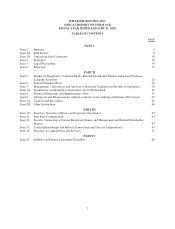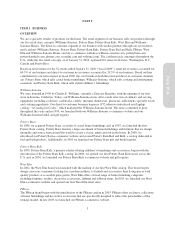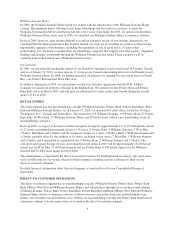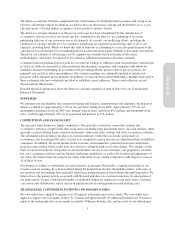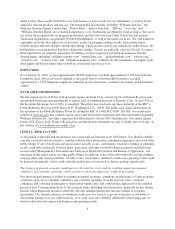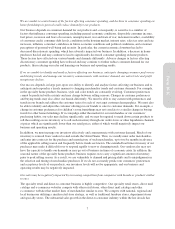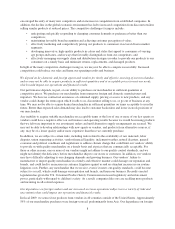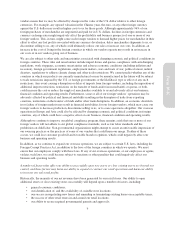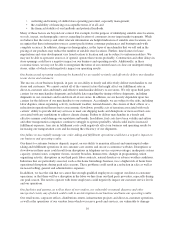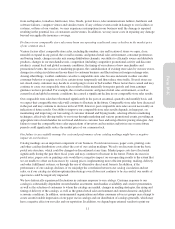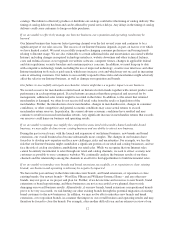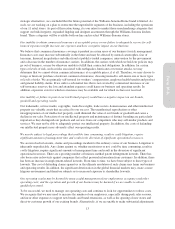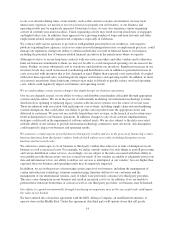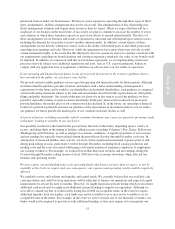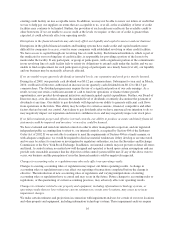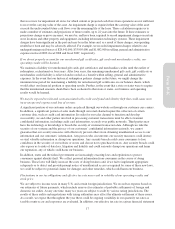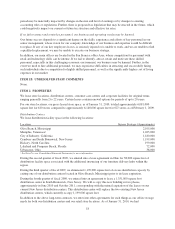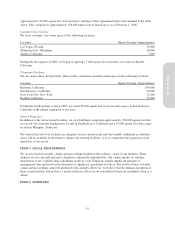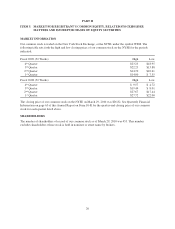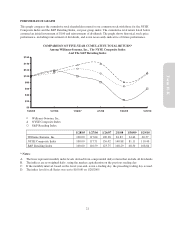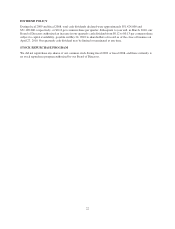Pottery Barn 2009 Annual Report Download - page 24
Download and view the complete annual report
Please find page 24 of the 2009 Pottery Barn annual report below. You can navigate through the pages in the report by either clicking on the pages listed below, or by using the keyword search tool below to find specific information within the annual report.catalogs. The failure to effectively produce or distribute our catalogs could affect the timing of catalog delivery. The
timing of catalog delivery has been and can be affected by postal service delays. Any delays in the timing of catalog
delivery could cause customers to forego or defer purchases.
If we are unable to effectively manage our Internet business, our reputation and operating results may be
harmed.
Our Internet business has been our fastest growing channel over the last several years and continues to be a
significant part of our sales success. The success of our Internet business depends, in part, on factors over which
we have limited control. We must successfully respond to changing consumer preferences and buying trends
relating to Internet usage. We are also vulnerable to certain additional risks and uncertainties associated with the
Internet, including changes in required technology interfaces, website downtime and other technical failures,
costs and technical issues as we upgrade our website software, computer viruses, changes in applicable federal
and state regulations, security breaches and consumer privacy concerns. In addition, we must keep up to date
with competitive technology trends, including the use of improved technology, creative user interfaces and other
Internet marketing tools such as paid search, which may increase costs and which may not succeed in increasing
sales or attracting customers. Our failure to successfully respond to these risks and uncertainties might adversely
affect the sales in our Internet business, as well as damage our reputation and brands.
Our failure to successfully anticipate merchandise returns might have a negative impact on our business.
We record a reserve for merchandise returns based on historical return trends together with current product sales
performance in each reporting period. If actual returns are greater than those projected and reserved for by
management, additional sales returns might be recorded in the future. In addition, to the extent that returned
merchandise is damaged, we often do not receive full retail value from the resale or liquidation of the
merchandise. Further, the introduction of new merchandise, changes in merchandise mix, changes in consumer
confidence, or other competitive and general economic conditions may cause actual returns to exceed
merchandise return reserves. In particular, the current adverse economic conditions have resulted and may
continue to result in increased merchandise returns. Any significant increase in merchandise returns that exceeds
our reserves could harm our business and operating results.
If we are unable to manage successfully the complexities associated with a multi-channel and multi-brand
business, we may suffer declines in our existing business and our ability to attract new business.
During the past several years, with the launch and expansion of our Internet business, new brands and brand
extensions, our overall business has become substantially more complex. The changes in our business have
forced us to develop new expertise and face new challenges, risks and uncertainties. For example, we face the
risk that our Internet business might cannibalize a significant portion of our retail and catalog businesses, and we
face the risk of catalog circulation cannibalizing our retail sales. While we recognize that our Internet sales
cannot be entirely incremental to sales through our retail and catalog channels, we seek to attract as many new
customers as possible to our e-commerce websites. We continually analyze the business results of our three
channels and the relationships among the channels in an effort to find opportunities to build incremental sales.
If we are unable to introduce new brands and brand extensions successfully, or to reposition or close existing
brands, our business and operating results may be negatively impacted.
We have in the past and may in the future introduce new brands, and brand extensions, or reposition or close
existing brands. Our newest brands – West Elm, PBteen and Williams-Sonoma Home – and any other new
brands, may not grow as we project and plan for. Further, if we devote time and resources to new brands, brand
extensions or brand repositioning, and those businesses are not as successful as we planned, then we risk
damaging our overall business results. Alternatively, if our new brands, brand extensions or repositioned brands
prove to be very successful, we risk hurting our other existing brands through the potential migration of existing
brand customers to the new businesses. In addition, we may not be able to introduce new brands and brand
extensions, or to reposition brands, in a manner that improves our overall business and operating results and may
therefore be forced to close the brands. For example, after another difficult year and an extensive review of our
12


